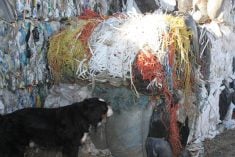A week after U.S. homeland security secretary Tom Ridge raised the terror threat alert level, Canadian livestock trucks were crossing the border without added delays.
“They’re rolling along,” said Mark Wendorff, truck dispatcher for Primrose Livestock in Lethbridge.
“It’s business as usual,” said Wendorff, who sent 18 trucks of cattle across the Coutts, Alta., and Sweetgrass, Montana, border on March 24 without incident.
As a precaution before loading the liners, Wendorff phoned border officials to double-check the lineups at the busiest livestock port of entry between the two countries.
Read Also

Message to provincial agriculture ministers: focus on international trade
International trade stakeholders said securing markets in the face of increasing protectionism should be the key priority for Canada’s agriculture ministers.
Wendorff said security has been tight since the terrorist attacks of Sept. 11, 2001, but this past week hasn’t been any worse since the terror threat alert level was raised from yellow to orange a week earlier.
On the U.S. five-colour-coded terror alert system, yellow represents an elevated threat, orange is high and red represents a severe risk.
Nick Santangelo, with the Western Hog Exchange in Lethbridge, said there have been no added delays at the border for truckloads of hogs crossing into the United States.
Since Sept. 11, he has worked closer with border officials to eliminate holdups.
“Generally we do call down to the border. We always let them know we have a load coming. There have been times when they’ve been held up.”
The Americans’ security plan Operation Liberty Shield includes increased monitoring of diseases and food security. The U.S. Department of Agriculture has alerted food producers to step up their security at feedlots, stockyards and storage areas.
Cherise Miles, public affairs officer for Customs and Border Protection under the Homeland Security Office in Chicago, Illinois, doesn’t anticipate a delay for livestock trucks crossing into the U.S.
“We don’t want to stop the flow of legitimate trade,” said Miles, who added customs agents will be extra vigilant in checking birth documents and load manifests.
“We will look at all personal documents, and manifests will receive greater security. For us there will be an increased amount of examination.”
Miles said a new X-ray machine at the border is used to see through containers without having to open them.
Gordon Luchia, communications manager for the Canada Customs and Revenue Agency, said there have been few delays along the southern Alberta border, even though Canadian customs agents are asking for added identification.
“The lineups are no different than they have been in the past.”














